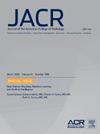Recent Trends in Academic Versus Nonacademic Radiologist Compensation and Clinical Productivity
IF 4
3区 医学
Q1 RADIOLOGY, NUCLEAR MEDICINE & MEDICAL IMAGING
引用次数: 0
Abstract
Background
Recent radiologist compensation and clinical productivity trends have not been well characterized, especially across academic versus nonacademic practice settings.
Purpose
To assess recent trends in in financial compensation and clinical productivity between academic and nonacademic settings in diagnostic radiology (DR) and interventional radiology (IR).
Materials and methods
We studied deidentified data from the Medical Group Management Association for both DR and IR physicians in academic and nonacademic practices from 2014 to 2023. Median, 25th and 75th percentiles, and mean values were analyzed for compensation, collections, and work relative value units (wRVUs). Compensation and productivity data were compared by radiology subspecialty (DR versus IR), practice type (academic versus nonacademic provider), geographical region of the United States, and practice size. Trends in absolute changes were analyzed with linear regression.
Results
The Medical Group Management Association Survey data for 2023 included responses for 3,769 radiologists (2,883 in DR and 886 in IR). In 2023, nonacademic radiologists had greater total median compensation than academic faculty in both DR (by 27%) and IR (by 32%). From 2014 to 2023, median compensation increased faster for academic DR physicians (3.2% annually) than for nonacademic DR physicians (1.9% annually). In 2023, DR physicians produced greater median wRVUs than IR physicians (by 53% for nonacademic and 46% for academic radiologists) with higher collections, but IR physicians had higher compensation (by 16% in nonacademic and 10% in academic settings). Over the last decade, IR physician compensation increased by 3.9% and 3.4% annually for nonacademic and academic IR physicians, respectively, whereas median wRVUs trended downward (by −1.5% for nonacademic and −2.4% for academic physicians) with declining collections (by −4.4% annually for nonacademic and −2.1% for academic physicians).
Conclusion
Over the last decade, the salary gap between academic and nonacademic radiologists has narrowed. Physician compensation has increased at a faster pace in IR, despite relatively lower clinical productivity and declining collections.
学术与非学术放射科医生薪酬和临床生产力的最新趋势。
背景:目的:评估诊断放射学(DR)和介入放射学(IR)学术和非学术环境下经济补偿和临床生产力的最新趋势:我们研究了医疗集团管理协会(MGMA)提供的 2014 年至 2023 年学术和非学术实践中 DR 和 IR 放射医师的去标识化数据。我们分析了报酬、收款和工作相对价值单位(wRVUs)的中位数、第 25 百分位数、第 75 百分位数和平均值。薪酬和生产率数据按放射学亚专业(DR vs IR)、医疗机构类型(学术机构 vs 非学术机构)、美国地理区域和医疗机构规模进行了比较。通过线性回归分析了绝对变化趋势:2023 年的 MGMA 调查数据包括 3769 名放射科医生的回复(2883 名 DR 医生和 886 名 IR 医生)。2023 年,在 DR(27%)和 IR(32%)中,非学术型放射医师的总薪酬中位数均高于学术型教师。从 2014 年到 2023 年,医学博士的薪酬中位数增长速度(每年 3.2%)高于非医学博士(每年 1.9%)。2023 年,DR 的 wRVU 中位数比 IR 高(非学术放射科医师比 IR 高 53%,学术放射科医师比 IR 高 46%),但 IR 的报酬更高(非学术放射科医师比 IR 高 16%,学术放射科医师比 IR 高 10%)。在过去十年中,非学术界和学术界 IR 医生的报酬年增长率分别为 3.9% 和 3.4%,而工作 RVU 中位数却呈下降趋势(非学术界为-1.5%,学术界为-2.4%),收入也在下降(非学术界为-4.4%,学术界为-2.1%):结论:在过去十年中,学术和非学术放射科医生之间的薪酬差距有所缩小。结论:在过去十年中,学术界和非学术界放射科医生的薪酬差距已经缩小。尽管临床生产力相对较低且收款下降,但红外放射科医生的薪酬增长速度更快。
本文章由计算机程序翻译,如有差异,请以英文原文为准。
求助全文
约1分钟内获得全文
求助全文
来源期刊

Journal of the American College of Radiology
RADIOLOGY, NUCLEAR MEDICINE & MEDICAL IMAGING-
CiteScore
6.30
自引率
8.90%
发文量
312
审稿时长
34 days
期刊介绍:
The official journal of the American College of Radiology, JACR informs its readers of timely, pertinent, and important topics affecting the practice of diagnostic radiologists, interventional radiologists, medical physicists, and radiation oncologists. In so doing, JACR improves their practices and helps optimize their role in the health care system. By providing a forum for informative, well-written articles on health policy, clinical practice, practice management, data science, and education, JACR engages readers in a dialogue that ultimately benefits patient care.
 求助内容:
求助内容: 应助结果提醒方式:
应助结果提醒方式:


